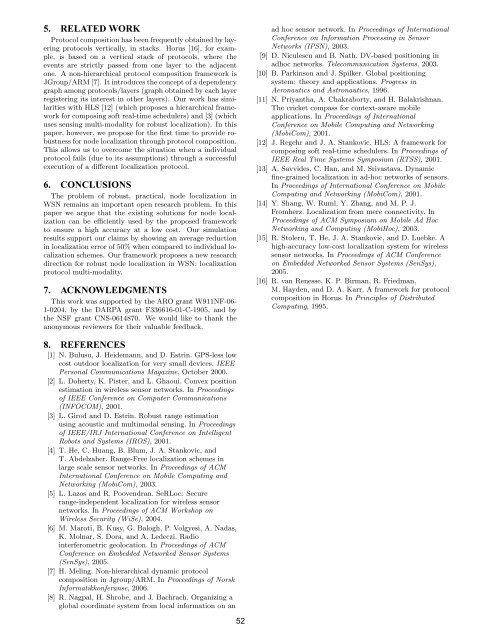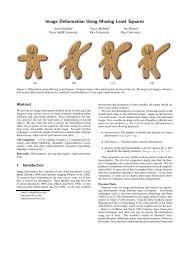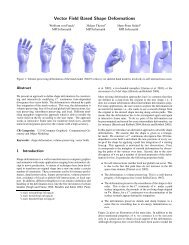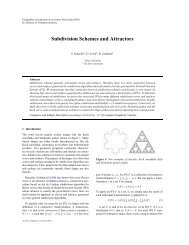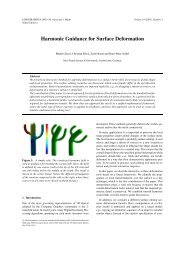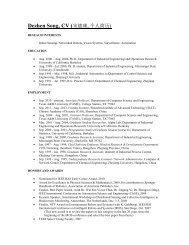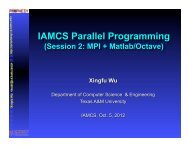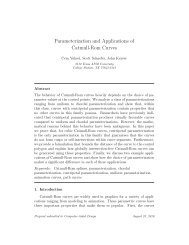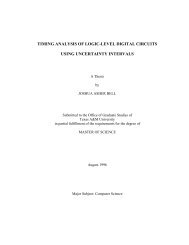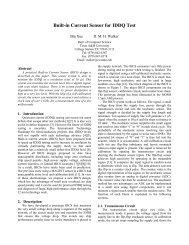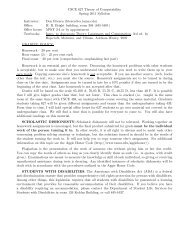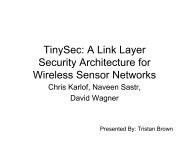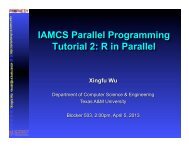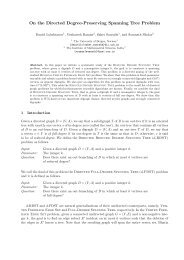Robust Node Localization for Wireless Sensor Networks - CiteSeerX
Robust Node Localization for Wireless Sensor Networks - CiteSeerX
Robust Node Localization for Wireless Sensor Networks - CiteSeerX
Create successful ePaper yourself
Turn your PDF publications into a flip-book with our unique Google optimized e-Paper software.
5. RELATED WORKProtocol composition has been frequently obtained by layeringprotocols vertically, in stacks. Horus [16], <strong>for</strong> example,is based on a vertical stack of protocols, where theevents are strictly passed from one layer to the adjacentone. A non-hierarchical protocol composition framework isJGroup/ARM [7]. It introduces the concept of a dependencygraph among protocols/layers (graph obtained by each layerregistering its interest in other layers). Our work has similaritieswith HLS [12] (which proposes a hierarchical framework<strong>for</strong> composing soft real-time schedulers) and [3] (whichuses sensing multi-modality <strong>for</strong> robust localization). In thispaper, however, we propose <strong>for</strong> the first time to provide robustness<strong>for</strong> node localization through protocol composition.This allows us to overcome the situation when a individualprotocol fails (due to its assumptions) through a successfulexecution of a different localization protocol.6. CONCLUSIONSThe problem of robust, practical, node localization inWSN remains an important open research problem. In thispaper we argue that the existing solutions <strong>for</strong> node localizationcan be efficiently used by the proposed frameworkto ensure a high accuracy at a low cost. Our simulationresults support our claims by showing an average reductionin localization error of 50% when compared to individual localizationschemes. Our framework proposes a new researchdirection <strong>for</strong> robust node localization in WSN: localizationprotocol multi-modality.7. ACKNOWLEDGMENTSThis work was supported by the ARO grant W911NF-06-1-0204, by the DARPA grant F336616-01-C-1905, and bythe NSF grant CNS-0614870. We would like to thank theanonymous reviewers <strong>for</strong> their valuable feedback.ad hoc sensor network. In Proceedings of InternationalConference on In<strong>for</strong>mation Processing in <strong>Sensor</strong><strong>Networks</strong> (IPSN), 2003.[9] D. Niculescu and B. Nath. DV-based positioning inadhoc networks. Telecommunication Systems, 2003.[10] B. Parkinson and J. Spilker. Global positioningsystem: theory and applications. Progress inAeronautics and Astronautics, 1996.[11] N. Priyantha, A. Chakraborty, and H. Balakrishnan.The cricket compass <strong>for</strong> context-aware mobileapplications. In Proceedings of InternationalConference on Mobile Computing and Networking(MobiCom), 2001.[12] J. Regehr and J. A. Stankovic. HLS: A framework <strong>for</strong>composing soft real-time schedulers. In Proceedings ofIEEE Real Time Systems Symposium (RTSS), 2001.[13] A. Savvides, C. Han, and M. Srivastava. Dynamicfine-grained localization in ad-hoc networks of sensors.In Proceedings of International Conference on MobileComputing and Networking (MobiCom), 2001.[14] Y. Shang, W. Ruml, Y. Zhang, and M. P. J.Fromherz. <strong>Localization</strong> from mere connectivity. InProceedings of ACM Symposium on Mobile Ad HocNetworking and Computing (MobiHoc), 2003.[15] R. Stoleru, T. He, J. A. Stankovic, and D. Luebke. Ahigh-accuracy low-cost localization system <strong>for</strong> wirelesssensor networks. In Proceedings of ACM Conferenceon Embedded Networked <strong>Sensor</strong> Systems (SenSys),2005.[16] R. van Renesse, K. P. Birman, R. Friedman,M. Hayden, and D. A. Karr. A framework <strong>for</strong> protocolcomposition in Horus. In Principles of DistributedComputing, 1995.8. REFERENCES[1] N. Bulusu, J. Heidemann, and D. Estrin. GPS-less lowcost outdoor localization <strong>for</strong> very small devices. IEEEPersonal Communications Magazine, October 2000.[2] L. Doherty, K. Pister, and L. Ghaoui. Convex positionestimation in wireless sensor networks. In Proceedingsof IEEE Conference on Computer Communications(INFOCOM), 2001.[3] L. Girod and D. Estrin. <strong>Robust</strong> range estimationusing acoustic and multimodal sensing. In Proceedingsof IEEE/IRJ International Conference on IntelligentRobots and Systems (IROS), 2001.[4] T. He, C. Huang, B. Blum, J. A. Stankovic, andT. Abdelzaher. Range-Free localization schemes inlarge scale sensor networks. In Proceedings of ACMInternational Conference on Mobile Computing andNetworking (MobiCom), 2003.[5] L. Lazos and R. Poovendran. SeRLoc: Securerange-independent localization <strong>for</strong> wireless sensornetworks. In Proceedings of ACM Workshop on<strong>Wireless</strong> Security (WiSe), 2004.[6] M. Maroti, B. Kusy, G. Balogh, P. Volgyesi, A. Nadas,K. Molnar, S. Dora, and A. Ledeczi. Radiointerferometric geolocation. In Proceedings of ACMConference on Embedded Networked <strong>Sensor</strong> Systems(SenSys), 2005.[7] H. Meling. Non-hierarchical dynamic protocolcomposition in Jgroup/ARM. In Proceedings of NorskIn<strong>for</strong>matikkonferanse, 2006.[8] R. Nagpal, H. Shrobe, and J. Bachrach. Organizing aglobal coordinate system from local in<strong>for</strong>mation on an52


